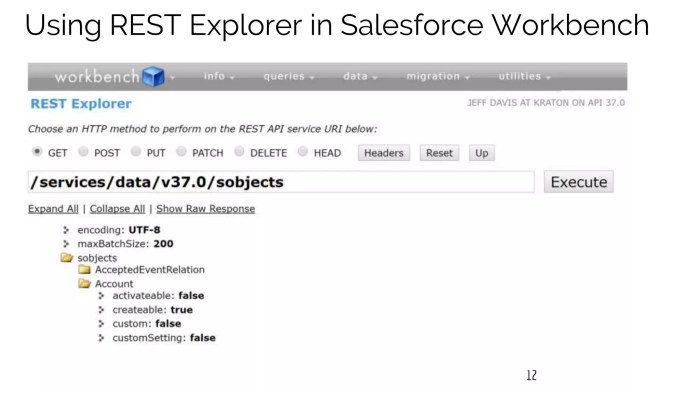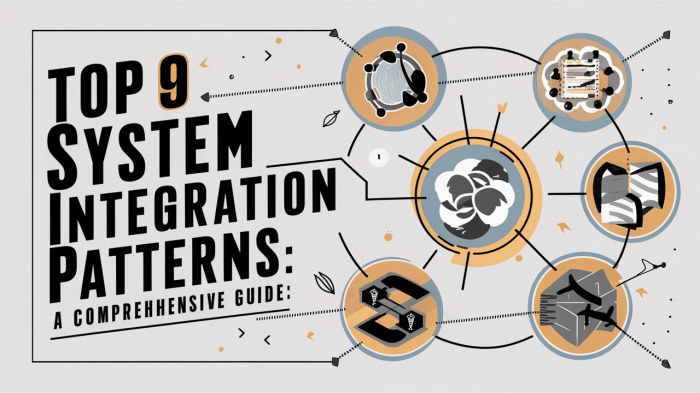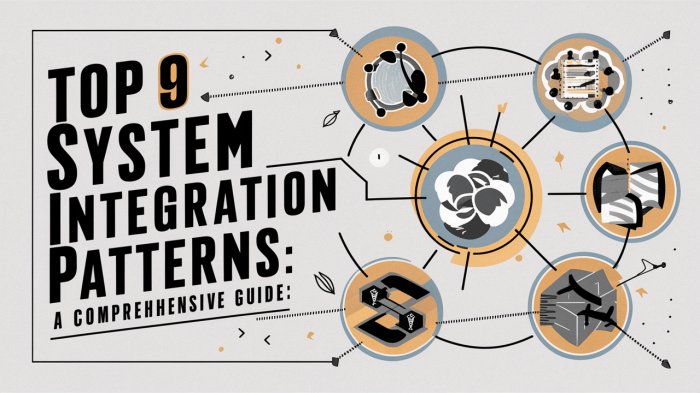Salesforce integration patterns a comprehensive guide for seamlessly connecting systems dives deep into the strategies and techniques for linking Salesforce to other systems. This guide explores various integration approaches, from API-based solutions to middleware configurations, providing a roadmap for successful implementations. We’ll examine common challenges, benefits, and best practices to ensure your Salesforce ecosystem works seamlessly with other platforms.
We’ll also dissect the pros and cons of different integration patterns and how to choose the right one for your specific needs.
From understanding the intricacies of data replication to mastering real-time integration, this guide will equip you with the knowledge to build robust, reliable, and scalable connections. We’ll cover crucial aspects like security, compliance, monitoring, and troubleshooting, making sure you have the tools to maintain a high-performing integration setup. Real-world case studies will illuminate the path forward, showcasing successful implementations and addressing potential pitfalls.
Introduction to Salesforce Integration Patterns
Seamless integration of disparate systems is crucial for modern businesses. Data silos hinder efficiency and limit the potential of a company’s resources. A well-defined integration strategy allows for real-time data flow, improved decision-making, and ultimately, increased profitability. Without proper integration, valuable information remains trapped within isolated systems, leading to missed opportunities and decreased operational agility.Integrating Salesforce with other applications is vital for leveraging its power.
This involves carefully selecting the right integration approach, choosing the most suitable tools, and adhering to established patterns. These patterns provide a structured framework for connecting Salesforce to other applications, mitigating risks, and ensuring a consistent, scalable, and maintainable solution. Different approaches cater to varying needs and complexities, ranging from simple API integrations to more complex middleware solutions.
Types of Salesforce Integrations
Different integration approaches cater to specific business needs and complexities. API-based integrations are straightforward for simpler connections, leveraging Salesforce’s robust APIs. Middleware integrations offer more flexibility for complex scenarios involving multiple systems, acting as a bridge between Salesforce and other applications. Custom integrations are tailored to unique requirements, providing maximum control but also requiring significant development effort.
Common Integration Challenges
Integration projects often encounter hurdles. Data format inconsistencies between systems can lead to errors and require significant data transformation efforts. Security concerns need careful consideration to protect sensitive information. Maintaining the integration solution over time, ensuring compatibility with evolving systems, and handling increasing data volumes can be challenging. Furthermore, the complexity of integrations can increase significantly as the number of systems involved grows.
Benefits of Defined Integration Patterns
Employing well-defined integration patterns provides several advantages. It improves the overall efficiency of the integration process, facilitating the connection of different systems. It reduces the risks associated with integrating disparate systems, mitigating errors and ensuring reliability. Maintaining the solution over time becomes easier, enabling scalability and adaptability to changing business requirements. It fosters a more organized and well-structured integration process, making it easier for future enhancements and modifications.
Salesforce integration patterns offer a fantastic way to connect systems seamlessly. It’s crucial to understand these patterns for smooth data flow, especially when dealing with various platforms. Speaking of platforms, did you know that Facebook now deletes live videos after 30 days? This change highlights the ephemeral nature of some online content, which can affect how businesses integrate with social media.
Thankfully, a deep dive into Salesforce integration patterns can help you navigate these complexities and build robust, future-proof systems.
Comparison of Integration Approaches
| Integration Approach | Description | Pros | Cons |
|---|---|---|---|
| Point-to-Point | Direct connections between individual systems. | Simplicity for small-scale integrations. | Difficult to manage as the number of connections increases; lack of centralized control. |
| Hub-and-Spoke | A central integration platform (the hub) connects to multiple other systems (spokes). | Centralized control, easier management, and scalability. | Complexity in setting up the hub; potential single point of failure. |
| Enterprise Service Bus (ESB) | A middleware platform providing communication and transformation services between systems. | High flexibility, robust data transformation, and security features. | Complex implementation; high initial investment. |
“Choosing the right integration pattern is crucial for successful Salesforce implementations. It depends on the specific needs and complexity of the integration.”
Common Salesforce Integration Patterns
Connecting Salesforce to other systems is crucial for a holistic business view. Understanding different integration patterns allows businesses to choose the approach best suited to their needs, ensuring smooth data flow and optimal system performance. These patterns are essential for streamlining operations and unlocking the full potential of Salesforce.Effective integration relies on choosing the right pattern. Each pattern offers specific advantages and disadvantages, impacting factors like implementation speed, long-term scalability, and maintenance overhead.
Careful consideration of these factors is paramount to successful integration.
Data Replication
Data replication involves copying data from one system (source) to another (target), often Salesforce. This pattern is valuable for maintaining consistency across systems. For example, a company might replicate customer data from a legacy system into Salesforce for better customer relationship management.
- Use cases include migrating data from older systems, creating backups, and providing a consistent view of data across multiple applications.
- A common scenario is replicating customer data from an older CRM system into Salesforce to maintain a complete customer profile.
API-Driven Integration, Salesforce integration patterns a comprehensive guide for seamlessly connecting systems
API-driven integration leverages Application Programming Interfaces (APIs) to exchange data between systems. This approach offers flexibility and control over data transfer, enabling precise and granular data exchange.
- Advantages include greater control over the integration process, flexibility in customizing data exchange, and potential for real-time updates.
- Salesforce’s robust API ecosystem facilitates seamless integration with various applications.
- A key benefit is the ability to customize the integration to meet specific business needs, ensuring accurate and efficient data flow.
Real-time Integration
Real-time integration ensures immediate data exchange between systems. This pattern is crucial for applications requiring instant updates, such as order processing or inventory management.
- Specific applications include order fulfillment systems, live chat support, and financial trading platforms.
- This pattern ensures that data is available in real-time for critical business functions.
Integration Approach Comparison
| Integration Approach | Ease of Implementation | Scalability | Maintenance |
|---|---|---|---|
| Data Replication | Medium | High | Medium |
| API-Driven Integration | High | High | Medium-High |
| Real-time Integration | Low | Medium | High |
Real-time integration, while offering immediate data visibility, demands sophisticated infrastructure and ongoing maintenance.
Use Case Examples
- Data Replication: Replicating product catalogs from an ERP system to Salesforce for accurate inventory management.
- API-Driven Integration: Automating order processing by integrating an e-commerce platform with Salesforce to manage customer orders and update inventory.
- Real-time Integration: Providing real-time stock updates on a product detail page in an e-commerce website, powered by a real-time integration with an inventory management system.
Choosing the Right Integration Pattern: Salesforce Integration Patterns A Comprehensive Guide For Seamlessly Connecting Systems

Selecting the appropriate Salesforce integration pattern is crucial for successful system connectivity. A poorly chosen pattern can lead to performance bottlenecks, security vulnerabilities, and significant development costs. Careful consideration of various factors, including data volume, system complexity, and real-time requirements, is essential for a seamless integration experience.Understanding the specific needs of your systems and the strengths and weaknesses of different integration methods is vital.
This involves evaluating data transfer volumes, the complexity of both your Salesforce instance and the external system, and the desired response time. Different integration patterns excel in different situations, and a suitable choice will optimize efficiency and scalability.
Factors to Consider When Selecting an Integration Pattern
Choosing the right integration pattern requires a comprehensive assessment of several key factors. Data volume, system complexity, and real-time requirements significantly impact the feasibility and efficiency of different integration methods. Understanding these factors allows for informed decisions, leading to robust and scalable solutions.
- Data Volume: The amount of data being transferred between systems is a critical factor. For high-volume data exchanges, batch processing or asynchronous integration might be more appropriate than real-time solutions due to their inherent scalability.
- System Complexity: The complexity of the systems being integrated influences the choice of pattern. Simple integrations might benefit from a simpler approach, while complex systems with multiple data points and intricate workflows might require more sophisticated integration strategies.
- Real-time Requirements: If the integration needs to respond in real-time, such as updating customer information as it changes, real-time messaging or event-driven architectures are essential. If real-time updates are not critical, other patterns like scheduled batch processing might suffice.
Assessing System Compatibility
Compatibility assessment is a vital step in the integration process. This involves verifying the ability of different systems to communicate effectively and exchange data according to predefined standards and protocols. Understanding the data structures, APIs, and protocols supported by both systems is essential.
- API Compatibility: Ensure both systems support the same or compatible APIs. Differences in API versions, data formats, or authentication methods can lead to significant integration challenges.
- Data Structure Alignment: Verify that the data structures in both systems align. Differences in data types, naming conventions, or field definitions will need careful mapping and transformation during the integration process.
- Protocol Support: Confirm that both systems support the chosen integration protocol. Different protocols have varying strengths and weaknesses, influencing the overall integration strategy and performance.
Evaluating Integration Solution Performance
Evaluating the performance of different integration solutions is critical for selecting the most efficient and scalable approach. Key metrics include data transfer speed, error rates, and system resource utilization.
- Benchmarking: Benchmarking different integration solutions using realistic data volumes and transaction rates is essential to identify performance bottlenecks and potential issues.
- Load Testing: Conduct load testing to evaluate how the integration handles increased data volume and user traffic.
- Monitoring: Implement monitoring tools to track key metrics, including response times, error rates, and resource consumption. This enables proactive identification and resolution of performance problems.
Steps in the Integration Pattern Selection Process
A structured approach to choosing the right integration pattern is crucial for success. This process involves clearly defining requirements, evaluating options, and selecting the best-suited pattern.
| Step | Description |
|---|---|
| 1. Define Requirements | Clearly articulate the goals, data exchange needs, and performance expectations of the integration. |
| 2. Evaluate Integration Patterns | Analyze the strengths and weaknesses of different patterns based on the defined requirements. |
| 3. Assess System Compatibility | Verify the ability of different systems to communicate effectively. |
| 4. Benchmark and Test Performance | Evaluate the performance of different integration solutions using realistic data and user traffic. |
| 5. Select and Implement | Choose the most suitable pattern and execute the integration project. |
Technical Requirements of Different Patterns
Different integration patterns have varying technical requirements, including programming languages, tools, and infrastructure.
So, you’re looking at Salesforce integration patterns – a great way to connect your systems seamlessly. But, thinking about how to actually use that connected data for growth? That’s where growth marketing comes in. Understanding how to leverage that data effectively is key to maximizing your business potential, which is why I recommend checking out this insightful guide on what is growth marketing and its benefits for your business.
Ultimately, a deep dive into salesforce integration patterns will help you make the most of those connections and drive tangible results for your company.
- Programming Languages: Some patterns might require specific programming languages (e.g., Java for Enterprise Integration Patterns). Others might be more flexible.
- Tools: Different integration tools support various patterns. Some might require custom development, while others might use pre-built integration solutions.
- Infrastructure: The chosen pattern might impact infrastructure requirements, such as message queues or cloud services.
Implementing Salesforce Integrations
Bridging the gap between your Salesforce platform and other systems requires a well-defined implementation strategy. This crucial step involves meticulous planning, careful configuration, and robust testing to ensure seamless data flow and optimal performance. Proper implementation ensures that your integrations are not just functional, but also scalable and adaptable to future needs.Effective implementation involves understanding the specific integration pattern chosen and configuring the chosen tools accordingly.
It also requires meticulous testing and troubleshooting to identify and resolve potential issues before the integration goes live. This approach guarantees a smooth transition and prevents costly delays or disruptions.
API-Based Integration Configuration
API-based integrations are a cornerstone of modern Salesforce implementations. They offer flexibility and scalability, allowing for customized data exchange between Salesforce and external systems. A crucial aspect is understanding the various Salesforce APIs available, including SOAP and REST. Each API has unique characteristics and usage patterns, and selecting the right one for your needs is essential.
- Step 1: Identify API endpoints. Determine the specific endpoints within the Salesforce API that will be used for the integration. This step involves thorough documentation review and careful planning.
- Step 2: Authenticate the connection. Implement secure authentication mechanisms to protect sensitive data. This often involves using OAuth 2.0, which is a standard for secure authorization.
- Step 3: Define data mapping. Establish the precise mapping between data fields in Salesforce and the external system. A clear mapping ensures accurate data transfer.
- Step 4: Implement data exchange logic. Develop the code to handle data retrieval, transformation, and insertion using the chosen programming language and libraries. Consider factors like data volume and frequency of exchange.
- Step 5: Test and debug the integration. Thoroughly test the integration to identify and address any issues before deployment. This involves unit testing, integration testing, and user acceptance testing.
Middleware Integration Configuration
Middleware integrations act as intermediaries between Salesforce and other systems, often handling complex data transformations and routing. They are particularly useful when dealing with legacy systems or systems that lack direct API access.
- Choose a suitable middleware platform. Select a middleware solution that aligns with your integration needs. Consider factors such as scalability, security, and ease of use.
- Configure middleware connections. Establish connections between the middleware platform and both Salesforce and the target system. Proper configuration is critical for successful communication.
- Define data transformations. Design the data transformations required to ensure compatibility between Salesforce data and the data format of the other system. These transformations might involve data cleansing, formatting changes, or other adjustments.
- Implement error handling and logging. Incorporate mechanisms to manage errors and log events during the integration process. This aids in troubleshooting and maintenance.
Data Replication Strategy
Implementing a data replication strategy ensures consistency between Salesforce and other systems. This often involves regularly copying data from one source to another. Different replication strategies are suitable for different data volumes and update frequencies.
- Identify data sources and targets. Determine the specific data sources and target systems for replication. This step is essential to plan the data flow accurately.
- Choose a replication method. Select a method that suits your needs. Consider factors such as data volume, update frequency, and desired level of automation.
- Schedule replication jobs. Establish a schedule for replication jobs to ensure data consistency and prevent data discrepancies.
- Implement error handling and monitoring. Include mechanisms to handle errors and monitor the replication process for optimal performance.
Testing and Debugging Integrations
Testing and debugging are crucial for ensuring the reliability and accuracy of Salesforce integrations. They help to identify potential issues early in the development cycle.
- Develop comprehensive test cases. Create detailed test cases to cover various scenarios and data conditions. Thorough test cases ensure a robust and dependable integration.
- Employ debugging tools. Utilize debugging tools to pinpoint errors and identify the root cause of issues. This often involves examining logs and tracing data flows.
- Simulate production environments. Establish test environments that mirror production environments. This approach ensures that the integration behaves as expected in real-world situations.
Tools and Technologies Supporting Integration Patterns
Various tools and technologies support different integration patterns, each with its own strengths and weaknesses. Choosing the right tool depends on the specific needs of your integration.
| Integration Pattern | Tools/Technologies |
|---|---|
| API-based | Salesforce APIs, REST clients (e.g., Postman), SOAP clients, programming languages (e.g., Java, Python) |
| Middleware | MuleSoft Anypoint Platform, Informatica PowerCenter, Dell Boomi |
| Data Replication | Salesforce Data Loader, ETL tools, third-party replication solutions |
Security and Compliance Considerations
Integrating Salesforce with other systems opens a world of opportunities, but also introduces significant security and compliance challenges. Robust security measures are paramount to protect sensitive data and maintain user trust. This section delves into crucial aspects of safeguarding Salesforce integrations, ensuring adherence to relevant regulations, and mitigating potential vulnerabilities.Implementing secure Salesforce integrations requires a proactive approach, recognizing that breaches can have substantial financial and reputational consequences.
Understanding the specific security concerns related to different integration methods and adopting appropriate safeguards is vital for maintaining data integrity and compliance.
Security Best Practices for Salesforce Integrations
Implementing strong security practices throughout the integration lifecycle is critical. This includes using strong passwords, multi-factor authentication, and regularly reviewing access controls. Furthermore, implementing encryption for data in transit and at rest is a crucial step in protecting sensitive information. Using least privilege access, limiting user permissions to only the necessary functionalities, is also a key practice.
Data Privacy and Security Concerns in Integrations
Data privacy and security are paramount when integrating Salesforce with other systems. Sensitive customer data, financial information, and other personally identifiable information (PII) need to be handled with extreme care. Integration processes must comply with relevant data privacy regulations, such as GDPR or CCPA, to avoid potential legal repercussions. Data breaches can lead to significant financial penalties and damage to an organization’s reputation.
Compliance Regulations Relevant to Salesforce Integrations
Numerous compliance regulations affect Salesforce integrations. These regulations may include industry-specific requirements, such as HIPAA for healthcare organizations, or legal mandates like GDPR for European Union citizens’ data. Thorough knowledge of these regulations and their application to specific integrations is essential. Non-compliance can result in substantial penalties and legal challenges.
Security Vulnerabilities Associated with Different Integration Methods
Different integration methods present varying security risks. Understanding these vulnerabilities is critical for implementing appropriate safeguards.
| Integration Method | Potential Security Vulnerabilities |
|---|---|
| API Integrations | Unauthorized access to sensitive data, insecure API keys, lack of rate limiting, injection vulnerabilities, and potential for data tampering during transmission. |
| Custom Integrations | Lack of comprehensive security testing, potential for vulnerabilities in custom code, insecure configuration settings, and insufficient access controls. |
| Integration Platforms | Potential vulnerabilities in the integration platform itself, security breaches in the platform’s underlying infrastructure, and insecure configuration of the platform’s settings. |
Importance of Access Controls and Authorization
Robust access controls and authorization mechanisms are fundamental to preventing unauthorized access to Salesforce data and functionality. Implementing granular permissions, role-based access controls, and secure authentication processes is essential to limit access to only those users who need it. Failure to implement adequate access controls can expose sensitive data and lead to security breaches. This includes the ability to track and audit user activity for better oversight.
Monitoring and Maintaining Integrations

Keeping your Salesforce integrations humming along smoothly requires proactive monitoring and a robust troubleshooting strategy. Ignoring potential issues can lead to data inconsistencies, lost sales opportunities, and ultimately, a frustrating user experience. This section delves into the critical steps for ensuring the long-term health and reliability of your integrations.
Monitoring Strategies for Salesforce Integrations
Monitoring Salesforce integrations is crucial for preventing downtime and identifying issues early. Real-time monitoring tools and dashboards provide a clear picture of the integration’s performance. These tools track key metrics like message throughput, latency, error rates, and successful delivery. Alerts based on these metrics are vital for swift intervention. For example, a sudden spike in error rates might signal a problem with the source system or a configuration change.
Regular reports generated from these dashboards help in identifying trends and patterns that indicate potential future problems.
Salesforce integration patterns offer a crucial pathway for connecting systems seamlessly. Understanding these patterns is key to a streamlined workflow, but effectively generating leads is just as important. Check out the 30 greatest lead generation tips tricks ideas for some actionable strategies to boost your lead generation game. Ultimately, robust lead generation combined with a deep understanding of Salesforce integration patterns creates a powerful synergy for any business looking to optimize their sales funnel.
Troubleshooting Integration Issues
A well-defined troubleshooting process is essential when problems arise. First, identify the specific issue by reviewing logs, error messages, and monitoring data. Is the problem related to data format, connection, or a specific Salesforce object? Pinpointing the root cause is the first step toward a resolution. A structured approach, such as the five whys, can be helpful in getting to the core of the problem.
Handling Integration Errors and Exceptions
Integration errors and exceptions are inevitable. A crucial aspect of any integration is how it handles these events. Robust error handling mechanisms are essential to prevent cascading failures and maintain data integrity. These mechanisms should include logging detailed error information, notifying the appropriate teams, and implementing recovery strategies. For instance, if a message fails to process, the system should retry the message after a configurable delay.
Implementing proper error handling prevents a single failure from bringing down the entire integration pipeline.
Common Integration Errors and Solutions
| Error Type | Description | Potential Solution ||—|—|—|| Connection Failure | The integration cannot connect to the source or destination system. | Verify network connectivity, check credentials, and ensure the systems are online. || Data Format Mismatch | Data sent from the source system doesn’t match the expected format in Salesforce. | Review data mappings, validate data formats, and implement data transformation logic if necessary.
|| API Rate Limits | The source system’s API limits are exceeded. | Implement throttling mechanisms, optimize data transfer processes, and use batch processing. || Salesforce Object Limits | Exceeding Salesforce API limits (e.g., record creation limits). | Implement batch processing, use asynchronous operations, and optimize queries. || Security Issues | Authentication or authorization problems during the integration.
| Review security configurations, ensure correct user permissions, and utilize appropriate security tokens. |
Ensuring Ongoing Stability and Performance
Maintaining the stability and performance of Salesforce integrations requires ongoing vigilance. Regular performance testing is crucial to identify potential bottlenecks. This includes testing with varying data volumes and user loads to anticipate and address performance issues before they impact users. Version control for integration code is also important to track changes and facilitate rollback if needed. Continuous monitoring and adjustments to the integration’s configuration are necessary to keep it performing at peak efficiency.
The ability to rapidly adjust to changing needs is a critical element for successful integration management.
Case Studies and Real-World Examples
Connecting Salesforce to other systems isn’t just about choosing the right pattern; it’s about understanding how it plays out in the real world. This section dives into successful implementations, the hurdles encountered, and strategies for scaling integrations across various industries. We’ll examine practical examples to illustrate the concepts and lessons learned.Successful Salesforce integrations aren’t just about technical prowess; they’re about understanding the business needs and how technology can support them.
This requires careful planning, meticulous execution, and a constant focus on the user experience.
Successful Salesforce Integration Projects
Real-world examples demonstrate the value of thoughtful integration planning. One example is a retail company that integrated their point-of-sale (POS) system with Salesforce. This allowed for real-time updates of customer purchase history, enabling personalized recommendations and targeted marketing campaigns. Another example is a healthcare provider that integrated their patient records with Salesforce to streamline administrative tasks and enhance patient communication.
Challenges Faced During Integration Implementations and Solutions
Integration projects, while beneficial, often encounter challenges. Data migration is a common hurdle, especially when dealing with large volumes of data. One solution involves using ETL (Extract, Transform, Load) tools to efficiently and accurately transfer data between systems. Data mapping errors can also lead to inaccuracies, requiring careful validation and testing. A robust testing strategy that includes both unit and integration tests is crucial.
Strategies for Handling Large-Scale Integrations
Large-scale integrations require careful planning and execution. A phased approach, where integrations are deployed in stages, can mitigate risks and ensure a smooth transition. Using cloud-based integration platforms simplifies the management of complex integrations and enables scalability. Additionally, using a dedicated integration team with clear roles and responsibilities is critical for large-scale projects.
Examples of Integrations Across Various Industries
Integrating Salesforce with other systems is not industry-specific. In finance, banks can use Salesforce to manage customer interactions and integrate with core banking systems for improved customer service. In manufacturing, companies can integrate Salesforce with ERP systems to streamline supply chain management and track inventory. In education, institutions can integrate Salesforce with student information systems for a centralized view of student data.
Key Lessons Learned from Case Studies
- Thorough planning is crucial for successful integrations. Clear goals, defined scope, and realistic timelines are essential.
- Data quality is paramount. Clean and accurate data from source systems is critical for accurate and reliable integration.
- Testing is not an afterthought. Comprehensive testing at every stage, from unit to integration, is vital for identifying and resolving issues early.
- Communication and collaboration between teams are essential. Keeping stakeholders informed throughout the project is critical for maintaining momentum and addressing concerns.
- Flexibility and adaptability are key to managing change. The ability to adapt to evolving needs and requirements is crucial for long-term success.
| Case Study | Industry | Integration Objective | Key Challenges | Solutions |
|---|---|---|---|---|
| Retail POS Integration | Retail | Real-time customer data for personalized marketing | Data volume, mapping errors | ETL tools, rigorous testing |
| Healthcare Patient Records Integration | Healthcare | Streamlined administration and enhanced patient communication | Data security, compliance | Secure data transfer protocols, compliance audits |
| Finance Customer Management Integration | Finance | Improved customer service, core banking system integration | Data security, complex system interactions | Secure APIs, thorough documentation |
Final Wrap-Up
In conclusion, mastering Salesforce integration patterns is key to maximizing the value of your Salesforce investment. This guide has provided a comprehensive overview of various patterns, implementation strategies, and critical considerations. By understanding the nuances of each approach and addressing security and compliance, you can build seamless integrations that support your business objectives. Remember, choosing the right pattern, meticulous implementation, and ongoing monitoring are crucial for a successful and sustainable integration strategy.






